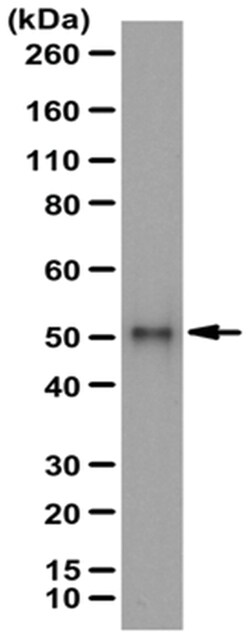Promotional price valid on web orders only. Your contract pricing may differ. Interested in signing up for a dedicated account number?
Learn More
Learn More
MilliporeSigma™ Rabbit anti-SPTLC1, Polyclonal,
Rabbit Polyclonal Antibody
Supplier: MilliporeSigma™ ABS1642
Description
Specifically detects SPTLC1 in Human samples, and it is validated for Western Blotting
Serine palmitoyltransferase 1 (EC 2.3.1.50; UniProt O15269; also known as LCB 1, Long chain base biosynthesis protein 1, Serine-palmitoyl-CoA transferase 1, SPT 1, SPT1) is encoded by the SPTLC1 (also known as HSAN1, HSAN1A, LCB1) gene (Gene ID 10558) in human. Serine palmitoyltransferase (SPT) catalyzes pyridoxal 5-phosphate-/PLP-dependent condensation of L-serine with palmitoyl-CoA to generate 3-ketodihydrosphingosine, the rate-limiting step for the de novo synthesis of sphingolipids. SPT belongs to the POAS (PLP-dependent α-oxoamine synthase) family of enzymes, members of this family also include 5-amino-levulinic acid synthase, KBL (2-amino-3 ketobutyrate ligase) and AONS (8-amino-7-oxononanoate synthase). Unlike the other known POAS family members that all exist as soluble homodimers, SPT is bound to the outer membrane of the endoplasmic reticulum (ER) as a multisubunit complex composed of three distinct subunits, SPTLC1, SPTLC2 and SPTLC3. SPTLC1 is a 473-amino acid sigle-transmembrane (a.a. 16-36) protein with a short N-terminal lumenal domain (a.a. 1-15) and a large C-terminal cytoplasmic domain (a.a. 37-473). Alternative splicing generates an isoform with a truncated cytoplasmic domain (D143 switched to E143, a.a. 144-473 truncated).
Specifications
| SPTLC1 | |
| Polyclonal | |
| O15269 | |
| Rabbit | |
| Unpurified | |
| RUO | |
| Primary | |
| Human | |
| Serum |
| Western Blot | |
| Rabbit polyclonal antibody serum with 0.05% sodium azide. | |
| SPTLC1; HSAN1; HSAN1A; LCB1 | |
| Two linear peptides corresponding to sequences from the N- and a C-terminal regions of human SPTLC1 cytoplasmic domain. | |
| 100 μL | |
| Signaling | |
| NP_006406 | |
| Stable for one year at -20°C from date of receipt. Handling Recommendations: Upon receipt and prior to removing the cap centrifuge the vial and gently mix the solution. Aliquot into microcentrifuge tubes and store at -20°C. Avoid repeated freeze/thaw cycles which may damage IgG and affect product performance. |
Product Content Correction
Your input is important to us. Please complete this form to provide feedback related to the content on this product.
Product Title
For Research Use Only
Spot an opportunity for improvement?Share a Content Correction
